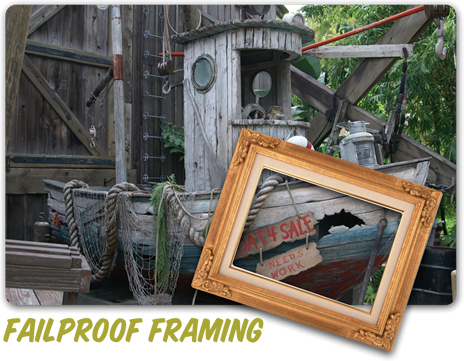When you’re looking to innovate, take advantage of an opportunity, or solve a problem… one of your first steps should be to define precisely or “frame” that opportunity or problem. Your frame is how you narrow and pinpoint what you choose to solve. Better framing leads to better solutions.
Think of it like a picture frame, it has in the center what you want to feature.
This old, wooden tugboat needs a lot of work. Among other things… an engine, new windows, paint… However, the priority is to fix the huge hole in the hull. That’s our frame.
It doesn’t mean things outside the frame won’t be addressed, however that big hole is the priority and our current area of focus.
But, let’s be honest. Determining the right focus isn’t always as clear as the hole in this tumbledown tug.
So, how can we really know what the frame should be?
One way to determine the right frame it to keep shifting perspectives. Take a look at the situation using different frame types, and test until you’ve found the right focus area.
You see movie directors doing this, forming a box with their thumb and index – framing to see how the scene will look on the screen… They keep shifting the perspective until they find what they want in the scene.
We do the same thing with problem solving. However, instead of shifting the position of our hands, we shift: time, people, risk, resources, and our perspective.

Time shift
How would this look from the future?
- It’s x months from now this decision worked well. What would we have accomplished?
- How would we have framed this x weeks ago?

People shift
See it from someone else’s point of view.
- How would our employees frame this?
- How would a client define the problem?
- How about the industry? The competition? Outsiders?

Risk shift
Explore it from a conservative to aggressive perspective.
- If we were unwilling to take a risk how would we define the problem?
- If we were a bunch of riverboat gamblers, what would we say about this opportunity?

Resource shift
How you would think about this if you had the ranges from no resources to unlimited.
- If money were no object, how would we define the problem?
- If we had to figure this out on a shoestring, how would we frame this?

Perspective shift
Think: Brick, Wall, or Cathedral? Test whether we’re looking at this decision from the right perspective.
- Brick – should this decision only affect small, limited-focus procedural steps or changes?
- Wall – should this decision be focused on a limited part of an overall, or organizational issue?
- Cathedral – does this decision affect the organization as a whole?
Next time you or your team is faced with a challenge – even when the problem behind that challenge can seem fairly clear – try a few different frames before you settle on the final approach.
You may find different frame changes the look of the whole picture.

